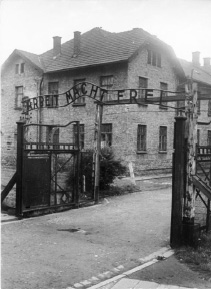Arbeit Macht Frei
All inmates of the Nazi concentration camps were subjected to a punitive labour regime that was, as established at Wannsee, intended to eventually work them to death. The cruel irony of the slogan Arbeit macht frei (‘work brings freedom’), which had first been used at Dachau and became infamous over the gates of Auschwitz, was evident across the whole camp system.

Arbeit Macht Frei over the entrance to Auschwitz I
Bundesarchiv, Bild 183-32279-007 / CC-BY-SA
On their minimal rations, inmates partook in hard physical labour for at least eleven hours a day. They toiled with little relief in all weather conditions and under constant surveillance. Among the most demanding tasks were shifting rocks and digging ditches. Much of the work contributed to the Nazi war effort or to the development of the camps themselves. The I.G. Farben factory, for example, manufactured synthetic rubber and fuels, while by spring 1944 prisoners had laid railway tracks directly into Birkenau.
Certain jobs were considered somewhat better, particularly those that were based indoors, such as in the hospital or kitchen. Chances of survival increased with a roof overhead, as it was rare for prisoners to possess anything more than a single layer of ragged and ill-fitting clothing. Occasionally people were assigned work related to their trade: Primo Levi, an Italian Jew and trained chemist, worked in the I.G. Farben factory; while former barbers were called upon to cut the hair of SS men. Musicians were assembled into an orchestra at Auschwitz and incongruously forced to play as their fellow prisoners marched out in labour columns each morning.
Women in Birkenau aspired to work in Kanada. This area was so-named because it was considered a land of plenty, where items ranging from clothing, shoes and glasses to prams, bedding and furniture rose in piles as high as the huts in which the women sorted them. These were possessions confiscated from new arrivals, deportation trains and the dead. Although valuables including jewellery or currency had to be deposited in sealed boxes, many women smuggled items they found out of Kanada, subsequently ‘organizing’ them to gain extra food. They were also able to take regular showers and permitted to let their hair grow.
Like any part of Auschwitz, however, Kanada was not without its dangers. There were several instances where prisoners were sexually abused and raped by SS guards. In addition, its proximity to one of the crematoria meant the women were witnesses to daily mass murder; therefore, they feared they would not be permitted to live indefinitely themselves.
Mauthausen-Gusen, in Austria, was a particularly notorious concentration camp. Men laboured underground in nearby quarries and the death toll was at least 95,000. As in Auschwitz, day-to-day existence in Mauthausen was characterized by appalling living conditions, insufficient nourishment and arbitrary, sadistic violence. In the middle of winter, prisoners were made to undress outside and then sprayed with cold water, whereupon they froze to death. In all the camps, cruel punishments were often instigated by Kapos, senior inmates who had been designated some authority and were frequently ruthless in their pursuit of order. Violent beatings were meted out for the smallest of perceived infractions and it was of little consequence to the perpetrators if a prisoner did not survive an assault.
The grimmest work of all took place in the extermination centres of Chelmno, Sobibor, Treblinka, Belzec and Auschwitz and was assigned to the Sonderkommando. This was the unit of prisoners forced to operate the gas chambers and crematoria, under the supervision of SS guards. The Nazis transferred the mental trauma of facilitating the killing process on to these prisoners, who were obligated to carry out their horrendous tasks if they wanted to retain any hope of survival.